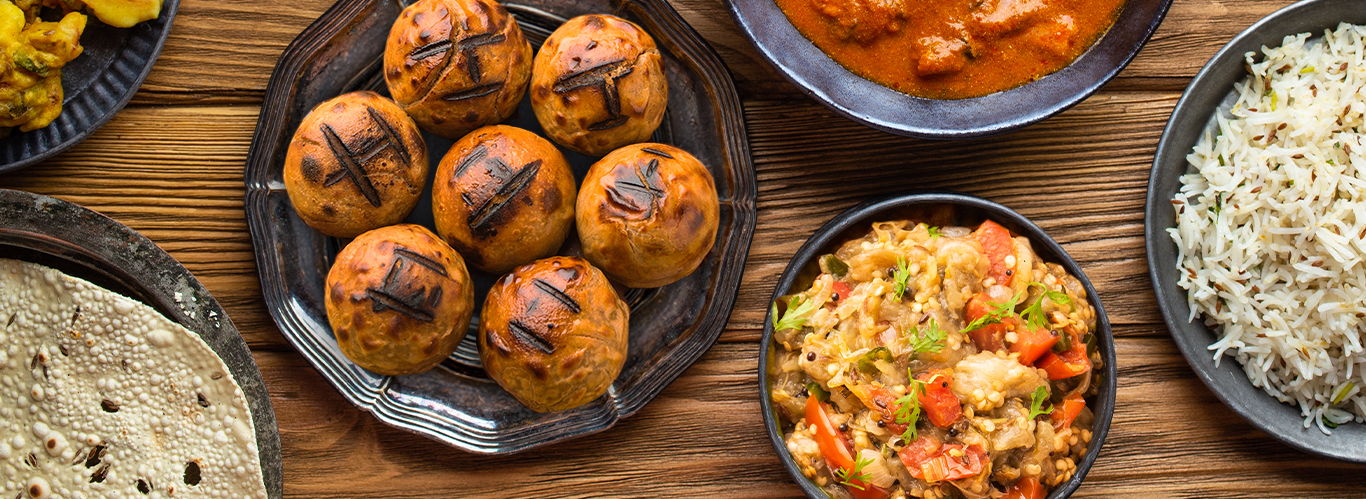Introduction
If you’ve ever travelled through Bihar or Jharkhand, chances are you’ve seen (or smelt!) Litthi Chokha being roasted on open flames at roadside stalls. It’s that one dish that defines the region—simple, smoky, packed with flavours, and full of nostalgia for those who grew up eating it. But Litthi Chokha isn’t just about food; it’s about tradition, history, and the kind of rustic cooking that connects people to their roots.
Let’s take a deep dive into the story behind this legendary dish, how it became a staple in Bihar street food, and why people across India are falling in love with it all over again.
A Journey Back in Time: The History of Litthi Chokha
Unlike fancy dishes with royal backstories, litthi chokha has always been food for the people. It started as a farmer’s meal—something nutritious, easy to carry, and long-lasting. Litthi, which is basically a wheat dough ball stuffed with spiced sattu (roasted gram flour), required no oil or fancy ingredients and could be cooked over open flames, making it the perfect meal for people working in the fields all day.
And then there’s Chokha, the perfect companion. Made with mashed roasted eggplant, tomatoes, and potatoes, it brings in that smoky flavour and spicy kick that balances out the nutty taste of litthi. A drizzle of mustard oil and a handful of fresh coriander? That’s where the magic happens!
Over the years, what started as a simple, survival meal slowly turned into a cultural icon. From street vendors to high-end restaurants, this beloved Jharkhand street food now has a fanbase across India, but its heart will always belong to Bihar and Jharkhand.
More Than Just Food: Cultural Significance & Traditions
Ask anyone from Bihar, and they’ll tell you—Litthi Chokha isn’t just food; it’s an emotion. It’s something families cook together, something that brings back childhood memories of sitting around a clay chulha (stove) while litthis roast slowly, filling the air with that distinct smoky aroma.
It’s also a festival favourite, especially during Chhath Puja, where it is offered as prasad. The simplicity of the dish aligns with the spirit of the festival—pure, earthy, and full of gratitude for nature’s gifts.
And let’s not forget the street food scene! Walk through the bustling lanes of Patna, Gaya, or Ranchi, and you’ll find vendors expertly roasting litthis on open coal fires, crushing hot roasted veggies for Chokha, and serving it all with a dollop of ghee and some spicy green chutney. It’s an experience in itself!
Anatomy of a Classic: Ingredients & Preparation
One of the coolest things about litthi chokha is that it doesn’t need expensive ingredients or complex cooking methods. You could be in a village with just basic supplies or in a modern kitchen with all the gadgets—it tastes just as amazing.
Litthi: The Roasted Goodness
Litthi is made by stuffing a simple whole wheat dough ball with sattu, mixed with mustard oil, ajwain (carom seeds), green chillies, and a squeeze of lemon juice. It’s then roasted until golden brown and slightly charred, giving it that rustic, smoky flavour.
Some people now bake litthis in ovens or even air-fry them, but ask any traditionalist, and they’ll swear—nothing beats litthis made over an open flame!
Chokha: The Smoky, Spicy Mash
Chokha is where all the flavours come together. The roasted eggplant, tomatoes, and potatoes are mashed up with mustard oil, garlic, onions, and fresh coriander. That slight rawness of mustard oil is what gives Chokha its signature punch!
Some variations add boiled peas, radish, or even raw mango for extra tanginess—it all depends on what’s available and how creative you want to get. Here’s the best way to enjoy litthi chokha
The perfect plate of litthi chokha has:
● Piping hot, crispy litthis straight from the fire.
● A generous serving of Chokha with that smoky, spicy flavour.
● A side of tangy pickles or green chutney for extra kick.
● A drizzle of melted ghee over litthis.
Some people even like to break open a litthi and dunk it into a bowl of dal for a heartier meal. And honestly? There’s no wrong way to eat litthi chokha—it’s all about what makes you happy!
Conclusion
In a world of fast food and fusion dishes, you would think a dish as old as litthi chokha would fade away. But nope—it’s only getting more popular! More people are now craving authentic, regional food, and litthi chokha ticks all the boxes—it’s healthy, satisfying, and packed with nostalgia.
Even celebrities and chefs are bringing it into the spotlight, and modern twists (like tandoori versions) are keeping things fresh while staying true to the original taste.
Litthi Chokha isn’t just another dish—it’s a symbol of Bihar’s street food, which connects you to its heritage, resilience, and love for simple, wholesome food. Whether you’re eating it at a roadside stall, making it at home, or trying it for the first time, it’s a dish that truly connects people to the heart of Indian culinary tradition.
For anyone looking to recreate the authentic taste of Litthi Chokha at home, choosing the premium ingredients from Sunrise Spices can make all the difference.
FAQs
1. Can I make litthi chokha in an oven?
Yes, baking litthi in an oven works if you don’t have access to an open flame. While the smoky flavour from roasting over a fire adds authenticity, the oven method still delivers a delicious result.
2. Can I use other vegetables in Chokha?
Yes, chokha can be made with a variety of vegetables. Some variations include using radishes, raw mangoes, or even pumpkin, depending on what’s in season and available.
3. How can I get the smoky flavour in chokha if I don’t have an open flame?
While traditional Chokha uses roasted vegetables, you can replicate the smoky flavour by grilling the vegetables or using a kitchen torch to char the skin.
